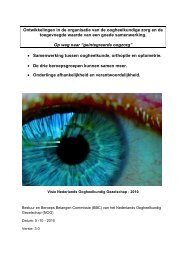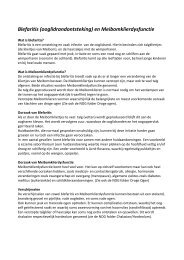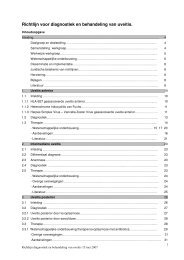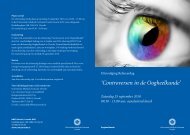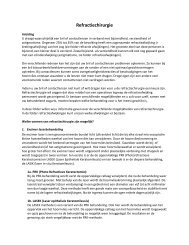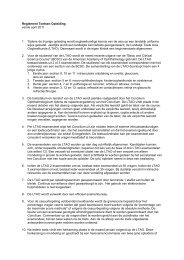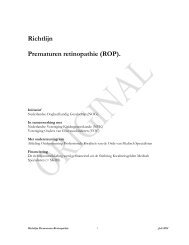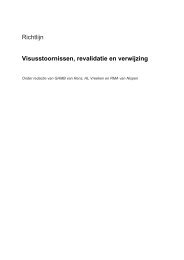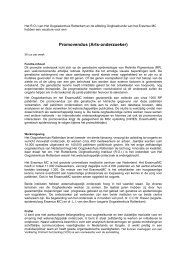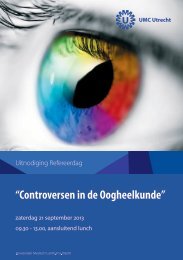terminology and guidelines for glaucoma ii - Kwaliteitskoepel
terminology and guidelines for glaucoma ii - Kwaliteitskoepel
terminology and guidelines for glaucoma ii - Kwaliteitskoepel
You also want an ePaper? Increase the reach of your titles
YUMPU automatically turns print PDFs into web optimized ePapers that Google loves.
2.2.4 - PRIMARY OPEN-ANGLE GLAUCOMA SUSPECT (POAG/HPG SUSPECT)<br />
See also Ch. Introduction <strong>and</strong> Ch. 2.2<br />
Etiology: Unknown<br />
Pathomechanism: Unknown<br />
Features:<br />
Visual field <strong>and</strong>/or optic disc <strong>and</strong>/or nerve fiber layer normal or suspicious, with at least one being suspicious<br />
Peak IOP > 21 mm Hg < 30 mm Hg without treatment (diurnal tension curve)<br />
Gonioscopy: open anterior chamber angle<br />
Risk factors to be considered:<br />
IOP difference > 4 mm Hg between the two eyes<br />
Peak IOP value<br />
Any other vascular risk factor <strong>for</strong> <strong>glaucoma</strong>tous optic neuropathy (See Ch. 2.2)<br />
POAG in fellow eye<br />
AION in fellow eye<br />
Note<br />
Pseudoexfoliation <strong>and</strong> pigment dispersion are risk factors <strong>for</strong> secondary open-angle <strong>glaucoma</strong>.<br />
High IOP is associated with, but not proven to be a causal factor of vein occlusion, especially in patients with high<br />
blood pressure, hypercholesterolemia or obesity.<br />
2.2.5 - PRIMARY OPEN-ANGLE GLAUCOMA/Normal-Pressure Glaucoma (POAG/NPG)<br />
See Ch. Introduction <strong>and</strong> Ch. 2.2<br />
Etiology: Unknown<br />
Pathomechanism: Unknown. Optineurin mutation has been found in families with NPG<br />
Features:<br />
Onset: from the 35th year onwards<br />
Signs <strong>and</strong> symptoms:<br />
Asymptomatic until field loss advanced<br />
Peak IOP < 22 mm Hg without treatment (diurnal tension curve)<br />
Optic nerve head damage typical of <strong>glaucoma</strong><br />
Disc hemorrhage<br />
Visual field defect typical of <strong>glaucoma</strong>; common paracentral defects<br />
Gonioscopy: open anterior chamber angle (exclude intermittent angle-closure; see Ch. 2.4.3)<br />
No history or signs of other eye disease or steroid use.<br />
Consider central corneal thickness if findings do not match (see Ch. 1.1)<br />
2.2.6 - POAG/Normal-Pressure Glaucoma Suspect (POAG/NPG-SUSPECT)<br />
Etiology: Unknown<br />
Pathomechanism: Unknown<br />
Features:<br />
Signs <strong>and</strong> symptoms:<br />
Visual field: normal or suspicious<br />
Optic disc <strong>and</strong>/or nerve fibre layer: findings not diagnostic of, but compatible with, the diagnosis of <strong>glaucoma</strong><br />
Peak IOP: < 22 mm Hg without treatment (diurnal tension curve or refeated measurements)<br />
Gonioscopy: open anterior chamber angle (exclude intermittent angle-closure see Ch. 2.4.3)<br />
Risk factors to be considered:<br />
IOP difference > 4 mm Hg between the two eyes<br />
Any other vascular risk factor <strong>for</strong> <strong>glaucoma</strong>tous optic neuropathy (See Ch. 2.2)<br />
NPG in fellow eye<br />
Consider corneal thickness if findings do not match (see Ch. 1.1)<br />
Ch. 2 - 7 EGS



